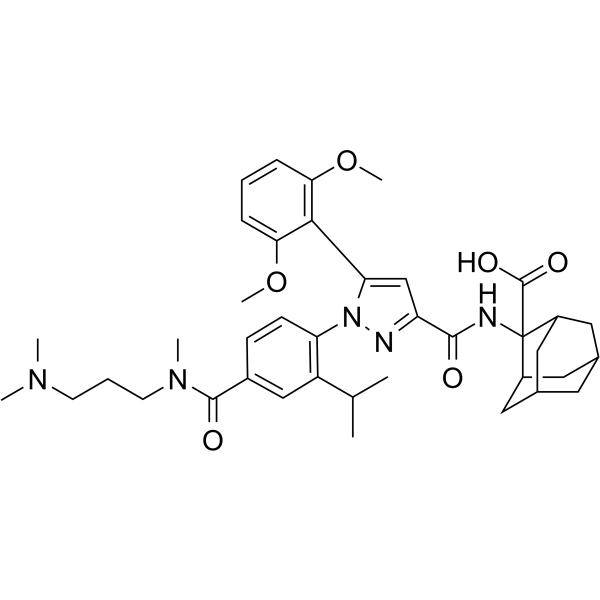| Description |
SR 142948 is an orally active, potent and selective non-peptide neurotensin receptor (NT1R) antagonist. SR 142948 antagonizes NT-induced inositol monophosphate formation in HT 29 cells with an IC50 of 3.9 nM. SR 142948 blocks hypothermia, analgesia and steering behavior induced by NT in vivo. SR 142948 shows blood-brain permeability, can be used in study of psychiatric disorders[1][2].
|
| Related Catalog |
|
| In Vitro |
SR 142948 (1 µM; 90 min) inhibits expression of c-fos and krox24 in CHO-hNT1-R cells[1]. SR 142948 (0-1 µM; 1 h) exhibits good antagonistic activity by inhibiting [125I-Tyr3]NT binds to h-NTR1-CHO and HT 29 cell membranes, with IC50s of 1.19 and 0.32 nM, respectively[2]. SR 142948 (0-1 µM; 30 min) antagonizes production of IP1 stimulated by NT both in h-NTR1-CHO and HT 29 cells, in a concentration-dependent manner[2]. SR 142948 (1, 10 nM; 60-80 s) antagonizes intracellular calcium mobilization stimulated by NT in h-NTR1-CHO cells[2]. Cell Viability Assay[1] Cell Line: CHO cells (expressing hNT1-R) Concentration: 1 µM Incubation Time: 90 min Result: Inhibited NT-stimulated expression of c-fos and krox24. Cell Viability Assay[2] Cell Line: CHO cells (expressing hNT1-R), HT 29 cells Concentration: 0-1 µM Incubation Time: 1 h Result: Inhibited the specific binding of [125I-Tyr3]NT to h-NTR1-CHO and HT 29 cell membranes in a dose-dependent manner (IC50=1.19, 0.32 nM, respectively). Cell Viability Assay[2] Cell Line: h-NTR1-CHO cells, HT 29 cells Concentration: 0-1 µM Incubation Time: 30 min Result: Antagonized the NT-induced IP1 production and intracellular calcium mobilization, with IC50s of 3.9, 11, and 53 nM for 10, 100 and 1000 nM NT, respectively.(in HT 29 cells). Inhibited IP1 formation induced by 10 nM NT in h-NTR1-CHO cells with an IC50 value of 9.7 nM. Cell Viability Assay[2] Cell Line: h-NTR1-CHO cells Concentration: 1, 10 nM Incubation Time: 60-80 s (Infuse for 40-60 s and incubate for another 20 s). Result: Abolished the ability of NT to increase free Calcium ions when at 10 nM. Inhibited the second peak of NT by 65% (S2/S1=0.35; S2/S1=1.12 (blank control)) when concentration at 1 nM.
|
| In Vivo |
SR 142948 (2 µg/kg; p.o.; single) inhibits the turning behavior induced by NT (10 pg/mouse)[2]. SR 142948 (0.01, 0.03, 0.3 mg/kg; i.p.; single) prevents the enhancement of ACh release produced by NT (100 nM), in a dose-dependent manner[2]. SR 142948 (0-10 mg/kg; p.o.; single) partially but significantly blocks NT-induced hypothermia (53% at 2 mg/kg in rats and 54% at 4 mg/kg in mice)[2]. Animal Model: Female Swiss albino CD1 mice (25-30 g; intrastriatal injection of 10 pg/mouse NT)[2]. Dosage: 2 µg/kg Administration: Oral administration; single. Result: Inhibited the turning behavior with maximal and significant antagonism between 1-2 h after administration. Animal Model: Male Sprague-Dawley rats (270-320 g; stimulation of 100 nM NT)[2]. Dosage: 0.01, 0.03, 0.3 mg/kg Administration: Intraperitoneal injection; single. Result: Inhibited NT-induced release of ACh, in a dose-dependent manner. Animal Model: Male OFA rats (130-160 g) and male OFA mice (25-30 g)[2]. Dosage: 0-10 mg/kg Administration: Oral administration; single. Result: Partially but significantly blocked NT-induced hypothermia (53% at 2 mg/kg in rats and 54% at 4 mg/kg in mice). The dose-response relationship was bell-shaped, with disappearance of the effect in both species at doses above 4 mg/kg.
|
| References |
[1]. Portier M, et al. Neurotensin type 1 receptor-mediated activation of krox24, c-fos and Elk-1: preventing effect of the neurotensin antagonists SR 48692 and SR 142948. FEBS Lett. 1998 Jul 31;432(1-2):88-93. [2]. Gully D, et al. Biochemical and pharmacological activities of SR 142948A, a new potent neurotensin receptor antagonist. J Pharmacol Exp Ther. 1997 Feb;280(2):802-12.
|
